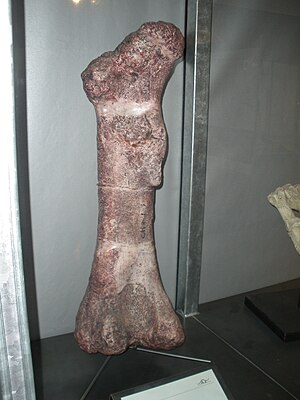Isanosaurus
| Isanosaurus | ||||||||||
|---|---|---|---|---|---|---|---|---|---|---|

Isanosaurus femur |
||||||||||
| Temporal occurrence | ||||||||||
| Upper Triassic (Upper Norium to Rhaetian ) | ||||||||||
| 214 to 201.3 million years | ||||||||||
| Locations | ||||||||||
| Systematics | ||||||||||
|
||||||||||
| Scientific name | ||||||||||
| Isanosaurus | ||||||||||
| Buffetaut et al., 2000 | ||||||||||
| Art | ||||||||||
|
||||||||||
Isanosaurus is a genus of sauropod dinosaur from the Upper Triassic of Thailand . The only species is Isanosaurus attavipachi . It is one of the oldest and most original known representatives of the sauropods, so the genus is of great importance for understanding the origin of this group. The relationship to other very early sauropods, such as Antetonitrus , Blikanasaurus or Gongxianosaurus , is unclear.
Isanosaurus was founded in 2000 by researchers to Éric Buffetaut described . The generic name ( Isan - Isan , designation for northeast Thailand; gr. Sauros - "lizard") indicates the area of discovery, while the second part of the species name ( attavipachi ) honors a long-time supporter of Thai paleontological research, the former director general of the Thai ministry for mineral resources P. Attavipach.
features
The only skeleton consists of fragmentary remains of cervical, dorsal and caudal vertebrae, ribs, chevron bones , a breastbone , a shoulder blade and a femur . This specimen is estimated to be about 6.5 meters long, the thighbone is 76 cm long. However, the vertebral bodies and vertebral arches were found separate from each other, which shows that these elements had not yet fused together - it was therefore probably a not yet fully grown animal.
The precursor forms of the sauropods (traditionally referred to as " prosauropods ") were originally two-legged. As one of the oldest known sauropods, Isanosaurus already showed the body structure that was typical of all later sauropods and was adapted to quadruped locomotion. The legs stood like a column under the body: the thigh bone was robust and straight, while it was still slightly S-shaped in “prosauropods” and another very original sauropod ( antetonitrus ). As a result of the columnar legs, bone ridges were also reduced, which served as muscle attachment points in “prosauropods” - for example, the small trochanter is missing .
Other important features can be found on the vertebrae. The cervical vertebrae were clearly opisthocoel , that is, with a convex front that fits into a concave rear of the adjacent vertebra, thus forming a ball- and- socket joint . The tail vertebrae, however, were amphicoel (concave on both sides). The spinous processes of the vertebrae were very high, as in some later sauropods, and were in contrast to the low spinous processes of the "prosauropods". The vertebrae were laterally concave; deep lateral cavities ( pleurocoels ), as they were later shown by sauropods, were missing.
Find
The skeleton was discovered in 1998 near the village of Ban Non Thaworn in Thailand's Chaiyaphum Province . The bones had been exposed on the surface for a long time, which is why the majority of the skeleton had already been destroyed by erosion when it was discovered . The site opens up dark red sandstones of the Nam Phong Formation , which are dated to the Upper Norium to Rhaetian . The vertebrate fauna of this formation is little known; In 2000, besides Isanosaurus, only one find consisting of two ischial legs was known. It is unclear whether this find could have belonged to Isanosaurus , as no ischial legs have been preserved in the Isanosaurus skeleton.
Individual evidence
- ↑ a b c d e f g h Eric Buffetaut , Varavudh Suteethorn , Gilles Cuny, Haiyan Tong, Jean Le Loeuff, Sasidhorn Khansubha, Sutee Jongautchariyakul: The earliest known sauropod dinosaur. In: Nature . Vol. 407, No. 6800, 2000, pp. 72-74, doi : 10.1038 / 35024060 .
- ^ Adam M. Yates, James W. Kitching: The earliest known sauropod dinosaur and the first steps towards sauropod locomotion. In: Proceedings of the Royal Society of London. Series B: Biological Sciences. Vol. 270, No. 1525, 2003, ISSN 0080-4649 , pp. 1753-1758, doi : 10.1098 / rspb.2003.2417 .
